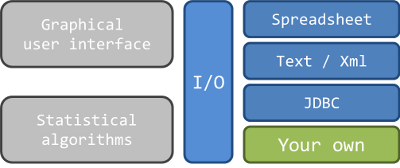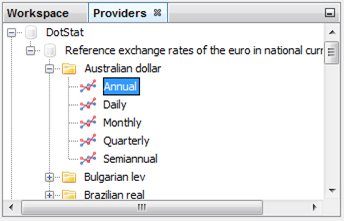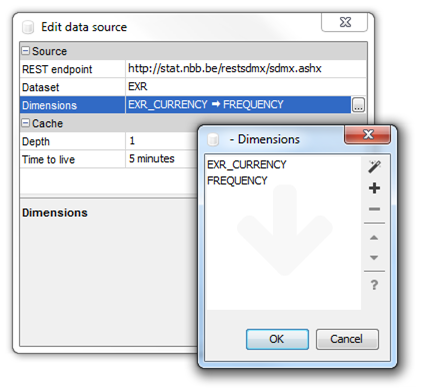-
Notifications
You must be signed in to change notification settings - Fork 30
TS Providers
The I/O operations in JDemetra+ are performed by specific modules called time series providers.
By default, JDemetra+ is bundled with a few useful providers allowing you to retrieve data from several sources such as spreadsheets and relational databases.
From user perspective, JDemetra+ seems to be a monolithic application designed to deal with seasonal adjustment only but the inside code is quite different. Actually, JDemetra+ is a modular java application that allows you to extend its capabilities and/or reuse its modules inside your own application.

Therefore, JDemetra+ is not limited to the providers bundled in. You can create and add your own.
To get started with the TS providers:
| Tool | How to get started |
|---|---|
| NetBeans IDE | Download the "Java SE" distribution of NetBeans IDE. This distribution contains all you need to build your own provider. |
| Command-line Maven | Maven is already integrated into NetBeans but you can download it as a standalone command-line tool. |
| Other IDEs | You can use any IDE that supports Maven-based projects. |
The purpose of a provider is to browse and retrieve data from a data store. These operations are done by browsing a hierarchical structure that handles two kind of objects:
- a DataSource, an object that represents a source of data such as a spreadsheet, a relational database, or any kind of data store. It contains all the information needed to access the source (path, url, some parameters...). A DataSource does not contain data but only a reference to it.
- a DataSet, an object that represents data in a DataSource such as a peculiar column of a sheet of a spreadsheet. It may represent either a collection or a time series. A DataSet does not contain data but only a reference to it.
For example, the following figure shows a DotStat data source called "Reference exchange rates ..." which contains several collections themselves containing several times series such as "Annual" or "Daily".

Depending on the provider, the DataSources might appear automatically or not. Most of the time, you have to add a new DataSource by opening the context menu on the chosen provider and clicking on the menu item named “Open”. This action will prompt a configuration dialog.

Once you get your DataSource in the hierarchy, you can retrieve its data by selecting a DataSet and either:
- using the clipboard (usual copy/paste)
- performing a drag & drop
- double clicking on it
Here are a few tips that might simplify the user's work:
- The DataSources can be converted to a convenient XML text that can be stored and loaded to avoid the configuration process.
- In the same idea, Demetra is able to remember the most recent used DataSources. Just open the context menu on a provider to do it.
- If the DataSource is a file, you can drag & drop it directly on a provider. This will trigger the configuration dialog.
- DataSources can be automatically opened at start up by opening the context menu on a DataSource and clicking on the menu item named “Toggle star”. Repeat the operation to cancel it.
- A DataSource can be sent to a coworker by email. To do so, open the context menu and click on the menu item named “Mail as xml”.
JDemetra+ provides a large set of APIs. You do not need to know or use all of them, just those that make sense in your specific context.
As for most of the APIs of JDemetra+, the engine (core) and the user interface (UI) are separated into different projets.
The TS providers core API is located in the package ec.tss.tsproviders of the demetra-jtss project.
Here are the most important classes:
| Type | Description |
|---|---|
| DataSet | Structure that defines a set of data such as a time series or a collection. |
| DataSource | Structure that defines a source of data such as a file, a database or any resource. |
| IDataSourceProvider | Defines a provider that is used to discover and browse DataSources and DataSets. |
| IDataSourceLoader | Defines a provider whose content can be changed programmatically. |
| IFileLoader | Defines a specialized provider whose source is a file. |
Note that the package ec.tss.tsproviders.utils contains some useful classes that simplify the implementation of a provider.
The TS providers UI API is located in the package ec.nbdemetra.ui.tsproviders of the nbdemetra-ui project.
Here are the most important classes:
| Type | Description |
|---|---|
| IDataSourceProviderBuddy | Customizes the UI elements of a provider such as the labels, icons and editors. |
Lookup is a NetBeans Platform API that handles loosely coupled communication. It is similar to but more powerful than the ServiceLoader class in JDK6.
It is used by JDemetra+ to get all providers available dynamically at runtime.
You can find an example of a random TS provider in the JDemetra+ tutorial.